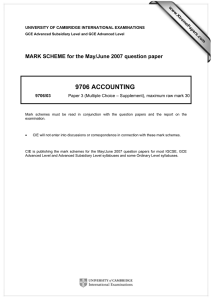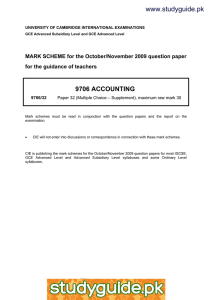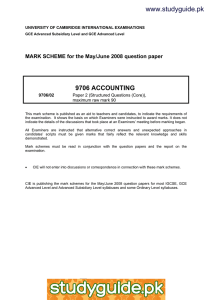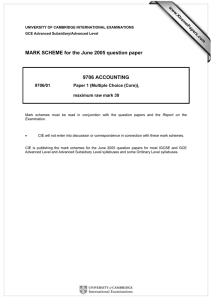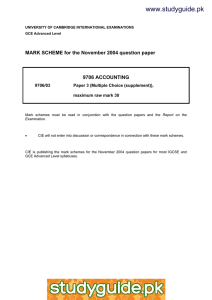9706 Accounting Mark Scheme: May/June 2008 Paper 2
advertisement
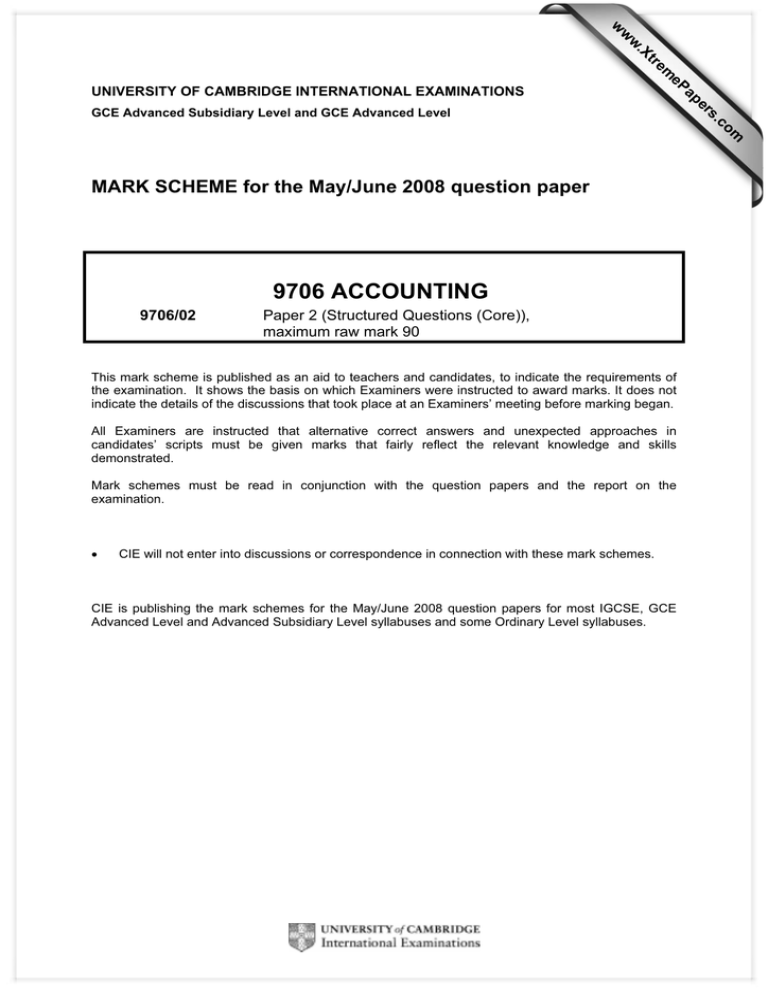
w w ap eP m e tr .X w UNIVERSITY OF CAMBRIDGE INTERNATIONAL EXAMINATIONS 9706 ACCOUNTING 9706/02 Paper 2 (Structured Questions (Core)), maximum raw mark 90 This mark scheme is published as an aid to teachers and candidates, to indicate the requirements of the examination. It shows the basis on which Examiners were instructed to award marks. It does not indicate the details of the discussions that took place at an Examiners’ meeting before marking began. All Examiners are instructed that alternative correct answers and unexpected approaches in candidates’ scripts must be given marks that fairly reflect the relevant knowledge and skills demonstrated. Mark schemes must be read in conjunction with the question papers and the report on the examination. • CIE will not enter into discussions or correspondence in connection with these mark schemes. CIE is publishing the mark schemes for the May/June 2008 question papers for most IGCSE, GCE Advanced Level and Advanced Subsidiary Level syllabuses and some Ordinary Level syllabuses. om .c MARK SCHEME for the May/June 2008 question paper s er GCE Advanced Subsidiary Level and GCE Advanced Level Page 2 1 (a) Mark Scheme GCE A/AS LEVEL – May/June 2008 Syllabus 9706 Paper 02 Trading and Profit and Loss account for the year ended 30 April 2008 $ $ Sales Less returns Less cost of sales Stock at 1 May 2007 Purchases Less returns 13 500 184 000 1 980 182 020 350 Add carriage in Less stock at 30 April 2008 Gross profit Discount received Rent receivable (2420 + 220) Doubtful debts provision (500 – 3% × (9000-200)) Bad debts written off Carriage out Discount allowed Electricity General expenses Depreciation on machinery Interest due on loan Net profit $ 243 000 2 040 240 960 (2100 – 40) (9340 + 50) ((52000 – 15600) × 40%) ((11% × 60000)/2) (1) 182 370 195 870 15 100 200 800 1 800 2 060 9 390 14 560 3 300 (1) 180 770 60 190 1 300 2 640 236 64 366 32 110 32 256 (1) (1) (1) (1) (1) (1) [8] © UCLES 2008 Page 3 Mark Scheme GCE A/AS LEVEL – May/June 2008 (b) Syllabus 9706 Paper 02 Balance Sheet at 30 April 2008 $ Fixed Assets Premises Machinery Current Assets Stock Debtors 8 800 Less DD Provision 264 Cash Prepayment Rent receivable Amounts due within one year Creditors Bank Accrual Interest due Net current assets $ $ Net Book Value 250 000 21 840 (1)of if < 36 400 271 840 15 100 8 536 990 40 220 11 460 8 260 50 3 300 must be 8800 and (1)of if DDP < 500 (1) (1) 24 886 23 070 1 816 273 656 Amount due over one year Long-term loan (11%) (1) (1) (1) (1)of 60 000 213 656 Proprietor's interest Capital at 1 May 2007 Add net profit 200 000 32 256 232 256 18 600 213 656 less drawings (1)of (1) (1) [11] (c) (i) Current ratio = 24886/23070 1.08:1 (1)of (ii) Liquid ratio = 9786/23070 0.42:1 (1)of (iii) Rate of stock turnover = 180770/14300 12.64 times (1)of (iv) Gross profit as a percentage of sales 28.87 days 24.98% (1)of (v) Net profit as a percentage of sales 13.39% (1)of (iv) and (v) denominator must be net sales i.e. not 243 000 Need suffixes. If correct working shown disregard request for decimal places [5] © UCLES 2008 Page 4 Mark Scheme GCE A/AS LEVEL – May/June 2008 Syllabus 9706 Paper 02 (d) (i) Ratios are used to compare a firm's performance with another year, or with another business of the same type. (ii) Interested parties might be: Bank manager Directors Competitors Customs and excise Creditors Investors/Shareholders Employees Debtors NOT Stakeholders The media (Newspapers, TV etc) Allow ONE group only of members of the firm Etc. One mark each to a maximum of [2] [4] [Total: 30] 2A Profit and loss balance Capital contribution Sales returns Depreciation (240 000 + 75 000) × 40% Interest accrued Drawings Stock Goods for own use Loan Equipment repairs Stock purchase $ – 100 000 80 000 no effect 126 000 10 000 $ + (1) (2) (1) (1) (1) (1) (1) (1) (1) 50 000 9 000 11 000 20 000 25 000 22 000 372 000 –81 000 291 000 81 000 (1) + (1)of [12] 2 marks for $291 000, 1 of provided EITHER (a) no entry for sales returns or (b) entry for sales/purchases returns in BOTH columns B (a) Sales Ledger Control Account Balance b/d 340 600 Credit sales 295 000 Bank 3600 Discount allowed 200 Balance c/d 8 340 Balance b/d 647 740 389 900 Balance b/d (1) Sales returns Bank (2) Discount allowed Contra Bad debt (1) Balance c/d 1 960 6 480 238 600 3 500 5 000 2 300 389 900 (1) Balance b/d 647 740 8 340 (1) (1) (1) (1) (1) (1)of (no aliens) (1) If Bank shown net 235 000 on credit side award (1) mark If Discount allowed shown net 3300 on credit side award (3) marks Do not award full marks for correct balances b/d as Bank may be shown as 3800 on debit side. [12] © UCLES 2008 Page 5 Mark Scheme GCE A/AS LEVEL – May/June 2008 (b) Overpayment Payment in advance Credit note issued Deposit received Etc. Syllabus 9706 Paper 02 1 mark each to maximum [3] (c) Less chance of fraud Less chance of errors Fraud or errors easier to find Checking easier Total debtors and creditors figures available Etc. 1 mark each to maximum [3] [Total: 30] 3 (a) $ Unit selling price Less Direct materials Direct wages Variable production overhead Variable sales overhead Unit contribution $ 1 100 128 625 40 30 (1) (1) (1) (1) (1) 823 277 [5] OR Sales Less Direct materials Direct wages Variable production overhead Variable sales overhead Total contribution Unit contribution 8 800 000 1 024 000 5 000 000 320 000 240 000 (1) (1) (1) (1) 6 584 000 2 216 000 277 (1) / 8 000 [5] OR Total contribution = Profit + Fixed costs 1 656 000 + 640/2 + 480/2 = 2 216 000 divided by 8000 for unit contribution = 277 1 2 2 The answer 307 should be awarded (4) marks. © UCLES 2008 [5] Page 6 Mark Scheme GCE A/AS LEVEL – May/June 2008 (b) BUY IN LEASE Syllabus 9706 Paper 02 EXTRA SHIFT $ (1) 2 200 000 (1) $ Sales 2 200 000 Less Buy in, lease, training 1 840 000 Direct materials Direct wages Variable production overhead Variable sales overhead 60 000 Total variable costs 1 900 000 $ (1) 2 200 000 (1) 260 000 256 000 1 250 000 80 000 (1) 60 000 (1) 1 906 000 (1) 50 000 (1) 256 000 (1) 1 437 500 (1) 80 000 (1) 60 000 (1) 1 883 500 (1) (1) (2) (1) (1) (1) Extra profit Alternative (wrong) answers (1)of 294 000 (4) 224 000 (3) (1)of 316 500 (7) (1)of 300 000 360 000 2 016 000 [22] The feasibility study is treated as a sunk cost - lose of mark for extra profit on leasing if feasibility cost included. Candidates may use a mix of methods between options, e.g. use the above for option 1 and the method below for options 2 and 3. There is no problem here. OR candidates may calculate the total rather than the additional profit and this is possibly most likely. Sales 11 000 000 Direct materials 1 024 000 Direct labour 5 000 000 Variable production overhead 320 000 Variable sales overhead 300 000 Fixed production overhead 320 000 Fixed sales overhead 240 000 Buy in, Lease, Training 1 840 000 Total costs 9 044 000 Profit 1 956 000 Original profit 1 656 000 Additional profit 300 000 (1) 11 000 000 1 280 000 6 250 000 400 000 (1) 300 000 320 000 240 000 (1) _ 260 000 9 050 000 (1)of 1 950 000 1 656 000 (1)of 294 000 (1) (1) (1) (1) (1) 11 000 000 1 280 000 6 437 500 400 000 300 000 320 000 240 000 (1) __ 50 000 9 027 500 (1)of 1 972 500 1 656 000 (1)of 316 500 (1) (1) (2) (1) (1) 1100 (1) 30 920 950 150 300 000 (1) (1) (1) (1) (1) (1) (1) (1) (1) (1) (2) (1) (1) (1) (1) (1)of (1)of [22] OR possibly a unit approach Selling price DM DL VPO VSO Buy in, Lease, Training Total costs Unit profit × 2000 = Added profit (1)of (1)of © UCLES 2008 1100 128 625 40 30 130 953 147 294 000 (1)of (1)of 1100.00 128.00 718.75 40.00 30.00 25.00 941.75 158.25 316 500 (1)of (1)of [22] Page 7 Mark Scheme GCE A/AS LEVEL – May/June 2008 Syllabus 9706 Paper 02 (c) Introduce an evening shift (or whichever is most cost-effective) (1)of Advantage - no need to spend so much money on training in future years. (1) Disadvantage - work involved in setting this up. (1) Or any other reasonable advantage/disadvantage. If candidate suggests answer not totally based on cost/profit, accept provided good reason given – e.g. (Advantage) buying in is simplest solution but (Disadvantage) can't guarantee quality. [3] The own figure mark cannot be given unless all three options are attempted. [Total: 30] There are, unfortunately, other possibilities for the three options which cannot be ignored, though they are unlikely to appear. Candidate may use the contribution figure calculated in the 3rd version of (a). $ $ Option 1 8000 × 277 (from (a)) 2000 × 1100 Buy in Sales o/h Original profit Fixed costs Option 2 Sales (1) (1) (1) less (7144 – 560) × 2 8 (1) Lease OR 10 000 × 277 less Lease Fixed costs Original profit 2 216 000 2 200 000 4 416 000 1 840 000 60 000 1 656 000 560 000 1 646 000 260 000 260 000 560 000 1 656 000 (1)of (1) (1) (1) (1) 4 116 000 300 000 (1)of 2 200 000 (1) 1 906 000 294 000 (1) (1) 2 770 000 (5) [5] [8] (1) 2 476 000 (1) 294 000 (1) [8] The figure $2 770 000 recognises the increase in sales, materials, variable production costs and sales overheads. © UCLES 2008 Page 8 Mark Scheme GCE A/AS LEVEL – May/June 2008 Option 3 Sales less (1) (1) (1) (7144 – 560) × 2 8 (1) 1 646 000 Training 50 000 Labour 187 500 (1) (1) Syllabus 9706 2 200 000 (1) 1 883 500 316 500 (1) (1) 2 770 000 (5) 2 453 500 316 500 (1) (1) Paper 02 [9] OR 10 000 × 277 less Training Labour Fixed costs Original profit 50 000 187 500 560 000 1 656 000 (1) (1) [9] Further possibilities: Option 1 Sales less purchases 2 200 000 (1) 1 840 000 (1) + (1) 360 000 (1) Only omission is variable costs so award an extra 1 for assumed sub-total Option 2 Contribution less costs (560 000 + 260 000) Profit Original profit Option 3 Contribution less Variable cost New contribution less fixed costs Training cost New Profit Additional profit (1 656 000 - 722 500) © UCLES 2008 2 770 000 820 000 1 950 000 1 656 000 294 000 (5) (1) (1) 2 770 000 1 437 500 1 332 500 560 000 772 500 50 000 722 500 933 500 (5) (1) [4] [8] (1) (1)of [7]
